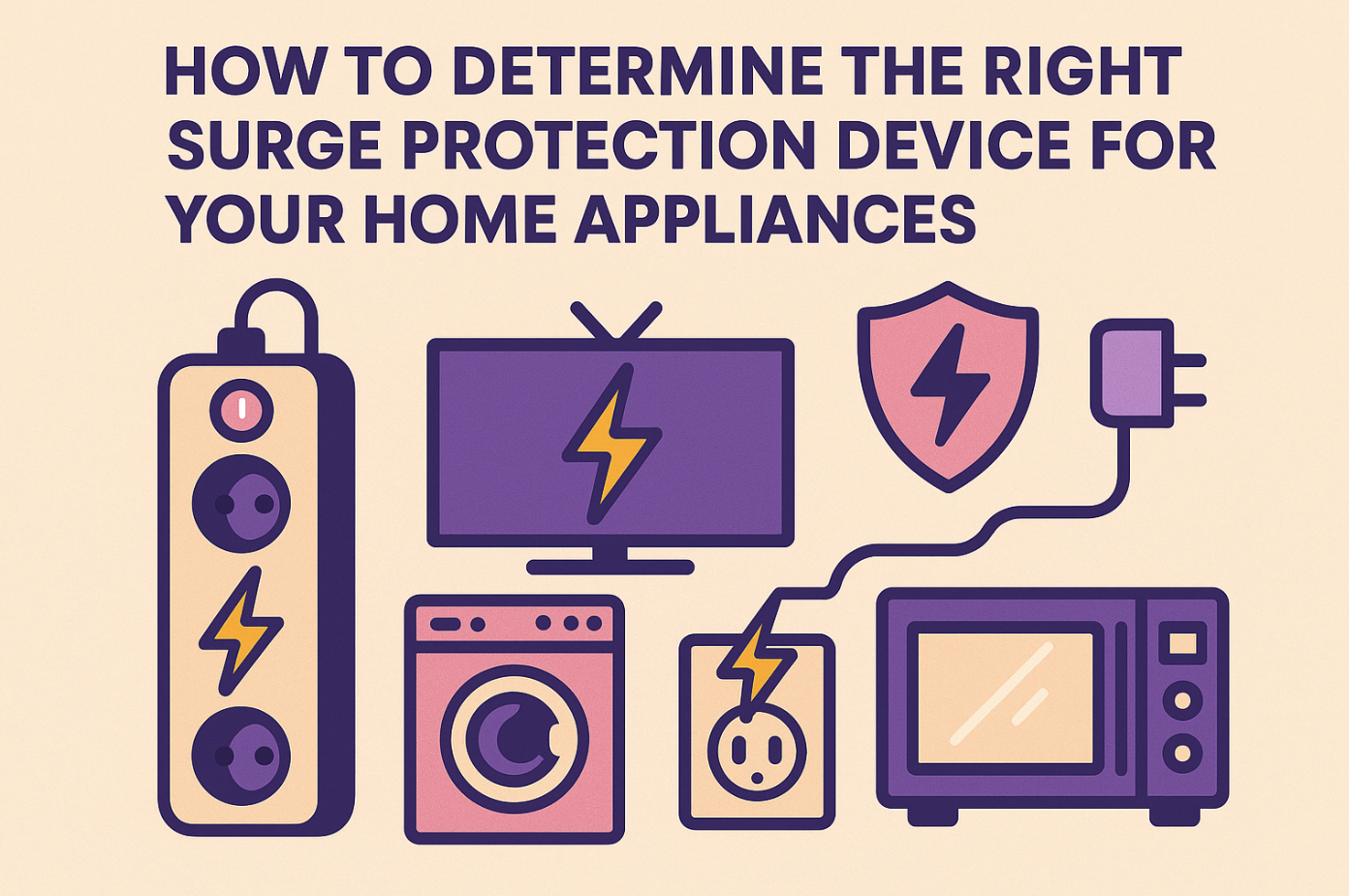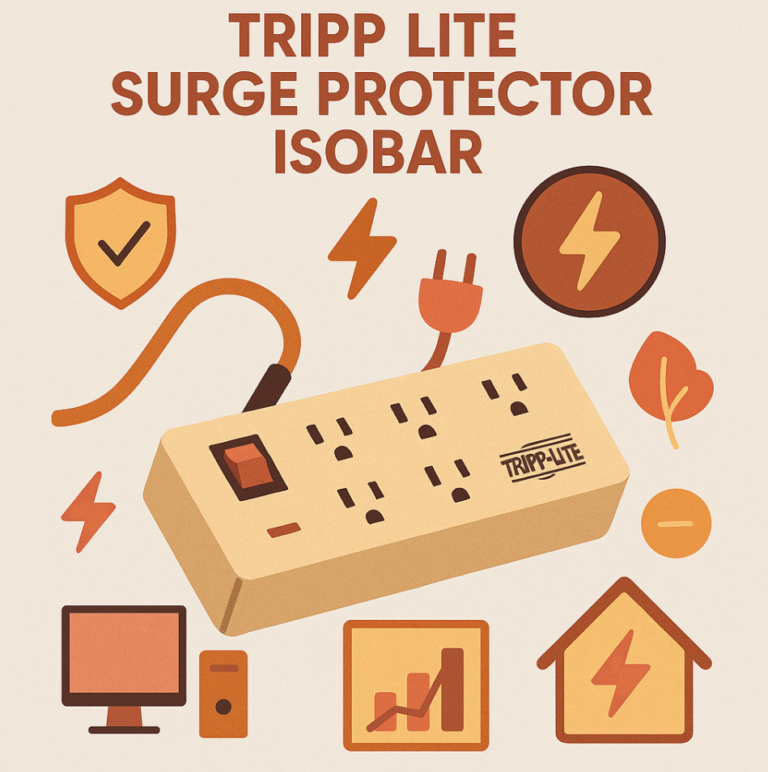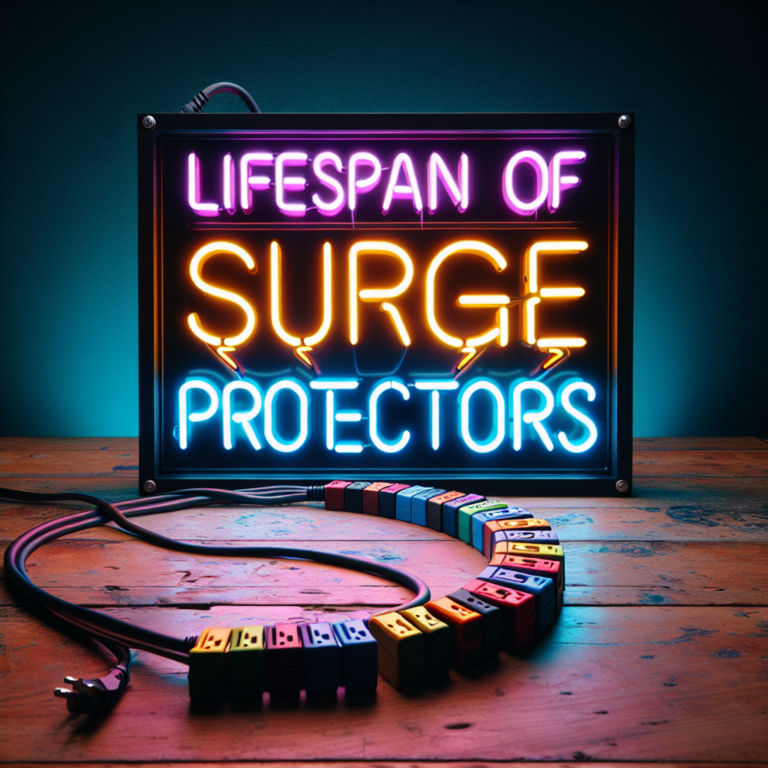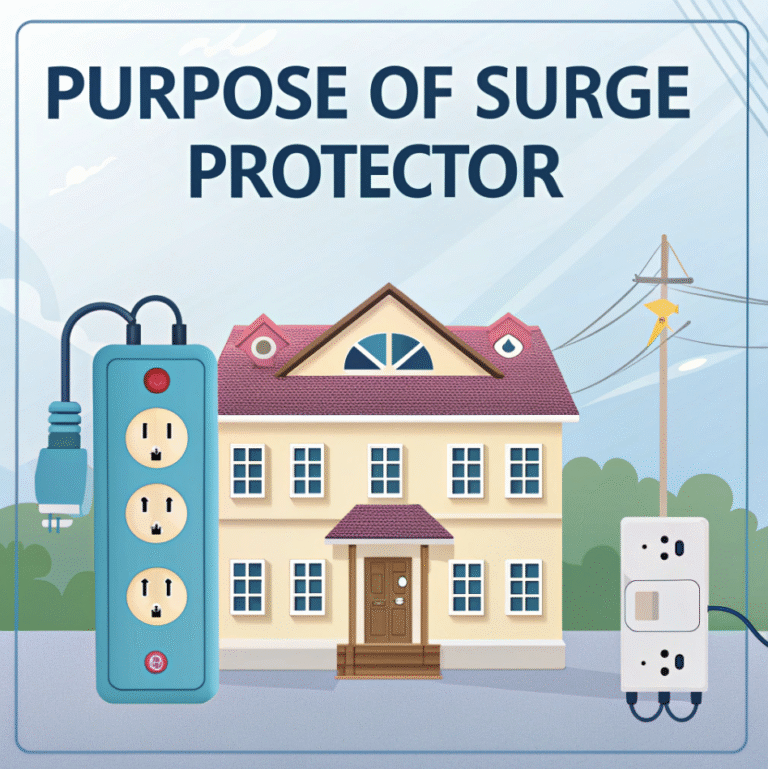How to Determine the Right Surge Protection Device for Your Home Appliances

Power surges can silently damage your home appliances, leading to costly repairs or replacements. A surge protection device acts as a shield, safeguarding electronics from voltage spikes caused by lightning or electrical faults. Reports show that power strips alone fail to protect motor-driven appliances like refrigerators, making surge protection essential.
The residential surge protection market, valued at $1.08 billion in 2023, is growing due to the rise in home electronics. To protect your appliances effectively, you must understand how to size surge protection devices by evaluating factors like voltage rating and surge current capacity.
Understanding Surge Protection Devices
What Are Surge Protection Devices?
A surge protection device is a tool designed to shield your home appliances from sudden voltage spikes. These devices work by limiting transient voltages and diverting excess current away from your electronics. They contain nonlinear components, such as varistors or suppressor diodes, which switch states during a surge. Under normal conditions, the device remains in a high-impedance state.
When a surge occurs, it shifts to low impedance, allowing it to redirect the surge safely. Once the surge passes, the device resets to its original state, ensuring continuous protection.
|
Feature/Principle |
Description |
|---|---|
|
Functionality |
Limits transient overvoltages and dissipates surge current. |
|
Connection Type |
Connected in parallel to the power supply circuits of the loads they protect. |
|
Components |
Includes varistors, suppressor diodes, and gas discharge tubes. |
|
Overvoltage Limitation |
Designed to divert strong lightning currents into the ground. |
How Do Power Surges Affect Home Appliances?
Power surges can wreak havoc on your appliances. A sudden voltage spike can fry sensitive electronics like TVs or computers. Frequent surges weaken internal components over time, reducing their lifespan and performance.
For example, CPUs and power adapters are particularly vulnerable to repeated voltage fluctuations. You might notice flickering lights or appliances failing prematurely, which are signs of surge-related damage.
These issues often occur during power outages or when power is restored, making surge protection essential for your home.
Why Are Surge Protection Devices Essential?
Surge protective devices play a critical role in safeguarding your home. Lightning strikes, utility grid fluctuations, and high-powered appliances can all cause surges. Without protection, these events can lead to overheating, component failure, or even fires.
The National Electrical Manufacturers Association (NEMA) estimates that the average home contains about $15,000 worth of electronics at risk. Installing surge protective devices not only prevents costly repairs but also extends the lifespan of your appliances. Additionally, they ensure a stable power supply, improving the efficiency of your electronics.
Types of Surge Protection Devices
Choosing the right surge protection device depends on your home’s needs and the level of protection you want. Surge protection devices come in three main types, each designed for specific applications and levels of coverage.
Understanding these types will help you make an informed decision.
Type 1: Whole-House Surge Protection
Whole-house surge protection devices are installed at the main electrical panel or the point where electricity enters your home. These devices provide the first line of defense against external power surges, such as those caused by lightning strikes or utility grid issues. They protect your entire electrical system, including all connected appliances and devices.
Tip: Whole-house surge protectors are ideal if you want comprehensive protection for your home. They can handle large surges and prevent damage to critical systems like HVAC units and home wiring.
Field studies highlight the effectiveness of whole-house surge protection systems. These devices can prevent electrical fires caused by surges, saving you from costly repairs or rebuilding.
They also protect expensive electronics, reducing the risk of damage and extending their lifespan. Some insurance companies even offer discounts to homeowners who install these systems, acknowledging the reduced risk of electrical damage.
|
Benefits of Whole-House Surge Protection |
Details |
|---|---|
|
Comprehensive Coverage |
Protects all appliances and devices connected to your home’s electrical system. |
|
Handles Large Surges |
Designed to manage surges from lightning strikes or utility grid fluctuations. |
|
Cost Savings |
Reduces repair costs and may qualify you for insurance discounts. |
|
Fire Prevention |
Minimizes the risk of electrical fires caused by overloads. |
Type 2: Panel-Level Surge Protection
Panel-level surge protection devices are installed at the electrical subpanel or distribution panel. These devices provide an additional layer of protection by safeguarding specific circuits or areas of your home. They are handy for protecting appliances that draw significant power, such as refrigerators, washing machines, and air conditioners.
Panel-level devices are designed to handle both Impulse and RingWave surges, ensuring optimal protection for your appliances. Real-world comparisons demonstrate that these devices effectively manage surges caused by internal sources, such as motor-driven appliances cycling on and off.
This makes them a valuable addition to your home’s electrical system.
Type 3: Point-of-Use Surge Protection
Point-of-use surge protection devices are the most common type and are typically found in the form of power strips or plug-in devices. These protect individual appliances or electronics by absorbing surges before they reach the connected device.
They are ideal for sensitive electronics, such as computers, televisions, and gaming consoles.
Case studies demonstrate the importance of point-of-use surge protection. For example, during a thunderstorm, a lightning-induced power surge damaged a refrigerator, television, and computer, resulting in repair costs of thousands of dollars.
A simple point-of-use surge protector could have prevented this damage. Similarly, a small business suffered a server failure due to a power surge, resulting in significant revenue loss.
Installing surge protectors could have avoided this costly incident.
|
Advantages of Point-of-Use Surge Protection |
Examples |
|---|---|
|
Appliance-Specific Protection |
Safeguards individual devices like TVs, computers, and gaming consoles. |
|
Cost-Effective |
Affordable and easy to install. |
|
Portable |
Can be moved and used with different devices as needed. |
|
Prevents Damage |
Protects sensitive electronics from sudden voltage spikes. |
How to Choose the Right Type for Your Home
Selecting the right surge protection device (SPD) for your home involves understanding your electrical system and the risks your appliances face. Each type of SPD—Type 1, Type 2, and Type 3—serves a specific purpose.
To make the best choice, you need to evaluate your home’s unique requirements and follow a structured approach.
Step 1: Understand the Types of SPDs
Start by familiarizing yourself with the three main types of surge protection devices. Type 1 SPDs protect your entire home from external surges, such as lightning strikes.
Type 2 SPDs safeguard specific circuits or areas, while Type 3 SPDs protect individual appliances or devices. Knowing these categories helps you match the device to your protection needs.
Step 2: Assess Your Risk Factors
Evaluate the likelihood of power surges in your area. Homes in regions prone to frequent lightning storms or unstable utility grids face higher risks. If you live in such an area, a Type 1 whole-house SPD is essential.
For homes with stable power and heavy appliance usage, a combination of Type 2 and Type 3 SPDs may be sufficient.
Step 3: Consider Your Appliances and Layout
Take note of the appliances you want to protect. High-value electronics, such as televisions, computers, and gaming consoles, benefit from point-of-use (Type 3) SPDs.
For motor-driven appliances like refrigerators and washing machines, panel-level (Type 2) SPDs provide better protection.
Additionally, measure the distance between your surge protector and the equipment. If the distance exceeds 10 meters, install an additional Type 2 or Type 3 SPD to ensure effective protection.
Step 4: Follow a Decision-Making Framework
Use a step-by-step framework to simplify your decision. The table below outlines key considerations:
|
Step |
Description |
|---|---|
|
1 |
Familiarize yourself with types, or categories, of SPDs. |
|
2 |
Assess the risk of lightning strikes and discharge capacities. |
|
3 |
Use the right devices to protect the surge protection itself. |
|
4 |
Install a Type 2 SPD with discharge capacity In>5kA for distribution panels. |
|
5 |
Consider the distance between the surge protector and the equipment. |
|
6 |
Refer to European HD 60364-5-53 for standards on surge protection. |
|
7 |
Choose a circuit breaker based on the short-circuit current of the building. |
Step 5: Match the SPD to Your Electrical System
Ensure the SPD you choose is compatible with your home’s electrical system. Check the voltage rating and discharge capacity of the device. For example, a Type 2 SPD with a discharge capacity of at least 5kA is recommended for distribution switchboards.
This ensures the device can handle surges effectively without compromising safety.
Step 6: Plan for Layered Protection
For optimal safety, consider a layered approach. Combine a Type 1 SPD at the main panel with Type 2 SPDs at subpanels and Type 3 SPDs for individual appliances.
This multi-tiered strategy provides comprehensive protection against surges from both external and internal sources.
By following these steps, you can confidently choose the right surge protection device for your home. This proactive approach not only safeguards your appliances but also gives you peace of mind during unexpected power surges.
How to Size Surge Protection Devices
Sizing a surge protection device correctly ensures your home appliances remain safe during power surges. To achieve this, you need to evaluate several key factors, including voltage rating, current capacity, and surge current rating.
Each of these elements plays a critical role in determining the effectiveness of your surge protection system.
Determine the Voltage Rating
The voltage rating of a surge protection device (SPD) must align with your home’s electrical system. This ensures the device can handle the maximum voltage without failing. Start by identifying the nominal voltage of your system. For most residential setups in the United States, this is typically 120V/240V.
However, you should also account for the Maximum Continuous Operating Voltage (MCOV). The MCOV should be at least 115% of the nominal voltage to provide adequate protection.
For example:
-
A 120V/240V system requires an MCOV of at least 138V (L-N) and 276V (L-L).
-
Ensure the SPD is UL Certified under the UL 1449 3rd Edition standard. This certification guarantees the device meets industry safety and performance benchmarks.
Tip: Always prioritize SPDs that have undergone rigorous performance testing, such as Nominal Discharge Current and Voltage Protection Rating (VPR) tests. These tests ensure the device can handle real-world surges effectively.
Assess the Current Capacity
The current capacity of an SPD determines the amount of electrical current it can safely handle during a surge. To size the device correctly, evaluate the rated power and operating current of all appliances you want to protect. This includes considering peak loads and starting currents, particularly for motor-driven devices such as refrigerators and air conditioners.
Here’s a step-by-step guide:
-
Calculate the total power requirement of your appliances.
-
Ensure the rated current of your main circuit breaker exceeds this total power requirement.
-
Match the SPD to the size of your main circuit breaker. For example:
-
If your main circuit breaker is rated at 200A, use a Type 1+2 SPD with a 50–80A circuit breaker or fuse.
-
For smaller systems, such as a 32A main circuit breaker, a Type 2+3 SPD with a 20A circuit breaker or fuse is sufficient.
-
|
Test Condition |
Result |
Notes |
|---|---|---|
|
Multi-pulse burst of 8/20 surges at rated current |
Damage observed in half of MOV samples |
Indicates inadequacy of single-pulse test |
|
Single 8/20 surge at rated current (60 seconds apart) |
No damage observed |
Suggests robustness under this condition |
|
Sixty 20 kA 8/20 surges spaced 60 seconds apart |
MOV did not fail |
Demonstrates resilience under spaced surges |
|
Five 20 kA 8/20 surges spaced 50 ms apart |
MOV failed |
Highlights vulnerability under rapid surges |
Consider the Surge Current Rating (kA)
The surge current rating, measured in kiloamperes (kA), indicates the maximum surge the device can handle without failing. This rating is crucial for protecting your home against severe power surges, such as those caused by lightning strikes.
The surge current rating should match the location and purpose of the SPD.
Here’s a breakdown of recommended surge ratings based on location:
|
Location |
|
|---|---|
|
Service panel |
300 |
|
Distribution panel |
200 |
|
Branch panels |
100 |
Testing protocols also provide valuable insights into the performance of SPDs under different conditions:
|
Current Test Level |
Nominal Load Cycle |
|
|---|---|---|
|
Type 1, 1CA |
Min. 5 kA, Max. 200 kA |
10 or 20 kA |
|
Type 2, 2CA |
1000 A, 500 & 100 A |
3, 5, 10 or 20 kA |
|
Type 3, 3CA |
N/A |
6kV/3kA |
|
Type 4 CA |
N/A |
0.01–20 kA |
|
Type 5 |
N/A |
0.01–20 kA |
By carefully evaluating these three factors—voltage rating, current capacity, and surge current rating—you can size a surge protection device that meets your home’s specific needs. This ensures your appliances remain safe and functional, even during unexpected power surges.
Evaluate Environmental Factors
Environmental conditions play a significant role in the performance and longevity of surge protection devices (SPDs). Ignoring these factors can lead to premature device failure or reduced efficiency. To ensure your SPD operates effectively, you must assess the environmental conditions in which it will be installed.
Key Environmental Factors to Consider
-
Temperature: Extreme temperatures can degrade the internal components of an SPD. High heat can cause thermal stress, while freezing temperatures may reduce the device’s responsiveness. Check the operating temperature range specified by the manufacturer to ensure compatibility with your location.
-
Moisture and Humidity: Excessive moisture can corrode the SPD’s components, leading to electrical faults. If you live in a humid or coastal area, choose a device with a high Ingress Protection (IP) rating. This rating indicates the device’s resistance to water and dust.
-
Pollution Levels: Dust, dirt, and chemical pollutants can accumulate on the SPD, affecting its performance. For industrial or urban areas with high pollution, opt for SPDs designed with protective enclosures or coatings.
-
Altitude: At higher altitudes, the air density decreases, which can impact the SPD’s ability to dissipate heat. Manufacturers often provide altitude-specific guidelines for their devices. Ensure your SPD is rated for your elevation.
Did You Know?
Studies highlight the impact of moisture, temperature, and other physicochemical exposures on the electrical parameters and structural integrity of SPDs. Surge arresters exposed to these environmental factors during operation may experience accelerated aging or even damage in extreme cases.
Match the SPD to Your Electrical System
Selecting an SPD that aligns with your home’s electrical system is crucial for effective surge protection. Mismatched devices may fail to provide adequate protection or could even damage your electrical setup.
To avoid these issues, you need to evaluate your system’s specifications and choose an SPD that fits seamlessly.
Steps to Match the SPD to Your System
-
Identify Your System’s Voltage
Determine the nominal voltage of your electrical system. Most residential systems in the United States operate at 120V/240V. Ensure the SPD’s voltage rating matches or exceeds this value. For example, an SPD with a Maximum Continuous Operating Voltage (MCOV) of 138V (L-N) and 276V (L-L) is suitable for a 120V/240V system. -
Check the System Configuration
Identify whether your system uses a single-phase or three-phase configuration. Single-phase systems are commonly found in homes, while three-phase systems are typically used in commercial buildings. Choose an SPD tailored to your specific configuration. -
Evaluate the Short-Circuit Current Rating
The SPD must handle the maximum short-circuit current of your system without failing. This rating ensures the device can withstand high fault currents during a surge event. Consult your electrician or utility provider to determine the short-circuit current of your system. -
Consider the Grounding System
Proper grounding is essential for SPD performance. Verify that your home’s grounding system complies with local electrical codes. An SPD connected to a poorly grounded system may not function correctly. -
Plan for Future Expansion
If you plan to add more appliances or circuits in the future, choose an SPD with a higher capacity. This ensures your surge protection system remains effective as your electrical needs grow.
|
System Parameter |
What to Check |
Recommended SPD Feature |
|---|---|---|
|
Voltage |
Nominal and MCOV ratings |
MCOV ≥ 115% of nominal voltage |
|
Configuration |
Single-phase or three-phase |
Match SPD type to system configuration |
|
Short-Circuit Current |
Maximum fault current |
SPD with adequate short-circuit rating |
|
Grounding |
Compliance with codes |
Properly grounded SPD |
|
Future Expansion |
Additional circuits or appliances |
Higher capacity SPD |
Matching the SPD to your electrical system ensures optimal performance and safety. This step protects your appliances and prevents costly electrical issues.
Sizing and selecting the right SPD involves clear steps: determine system voltage, assess surge risks, and match the device to your electrical setup. Consider surge current capacity, environmental factors, and compliance standards for optimal performance.
Take proactive measures to protect your electronics. Install layered surge protection, maintain your devices regularly, and replace them after major electrical events.
These actions ensure your appliances remain safe and functional, even during unexpected power surges.
FAQ
What is the best way to choose a surge protection device for my home?
Use a surge protection device selector to match your home’s electrical system and appliances. Consider factors like voltage rating, surge current capacity, and environmental conditions.
A surge protection device selection guide can simplify this process, ensuring you choose the right device for your needs.
How does lightning affect surge protection devices?
Lightning generates powerful voltage spikes that can overwhelm unprotected systems. A properly installed surge protection device diverts this excess energy, preventing damage to your appliances.
For areas prone to lightning, prioritize devices with high surge current ratings.
Can I install a surge protection device myself?
You can install point-of-use devices like power strips. However, whole-house or panel-level devices require professional installation. This ensures compliance with safety standards and optimal performance. Always consult an electrician for complex installations.
How often should I replace my surge protection device?
Replace your surge protection device every three to five years or after a significant surge event, such as a lightning strike. Regular inspections help identify wear or damage, ensuring continuous protection for your appliances.
Do surge protection devices work during power outages?
Surge protection devices do not prevent power outages. However, they protect your appliances from voltage spikes when power is restored. This makes them essential for safeguarding sensitive electronics during unpredictable electrical events.






